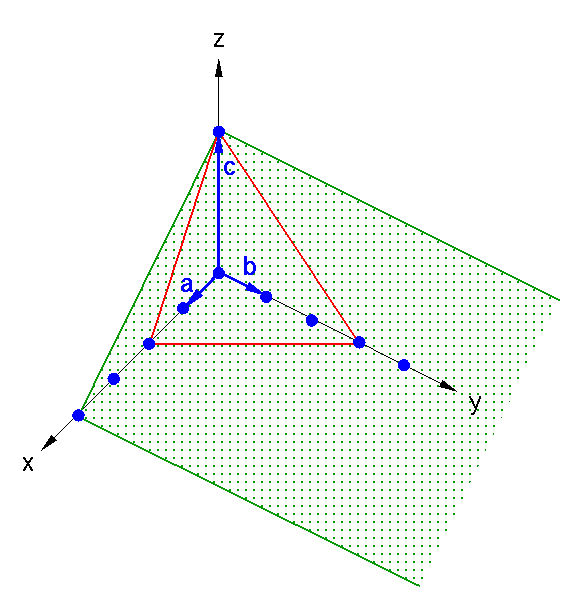In order to denote any plane through a crystal lattice we use a system devised by Miller in 1839, originally to describe the crystal faces. He defined three indices h, k, l as the reciprocal cut-offs with the three crystallographic axes. The triplet is placed in brackets, (hkl), and describes a set of parallel planes with a certain relative orientation to the crystal lattice.
The following is an easy way to find the values of h, k and l.

Example 1 (the red plane in the above illustration):
| 1. | Cut-offs: | 2 | 3 | 1 | ||||||
| 2. | Reciprocal: | 1/2 | 1/3 | 1/1 | ||||||
| 3. | Multiply by 6: | 6/2 | 6/3 | 6/1 | → | (3,2,6) |
Example 2 (the green plane):
| 1. | Cut-offs: | 4 | ∞ | 1 | ||||||
| 2. | Reciprocal: | 1/4 | 1/∞ | 1/1 | ||||||
| 3. | Multiply by 4: | 4/4 | 0 | 4/1 | → | (1,0,4) |
This procedure gives the Miller indices (hkl) or (h,k,l) of a plane in the crystal. However, these may or may not be the same as the reflection indices, also denoted by (hkl), which define the reciprocal lattice coordinates of a diffraction spot (more about this in a later section).
The difference between the Miller indices and the reflection indices is that the Miller indices never have a common factor; this is guaranteed by the above procedure for obtaining them. However the corresponding reflection indices may or may not have a common factor, because in principle a given crystal plane gives rise to an infinite number of orders of diffraction. So, for example, the reflections with indices (-3,0,-12), (-2,0,-8), (-1,0,-4), (1,0,4), (2,0,8), (3,0,12), etc. are all X-ray reflections from the crystal planes with Miller indices (1,0,4). In fact the reflection indices differ from the Miller indices by a factor equal to the order of diffraction n. Note that in practice crystallographers are only concerned with reflection indices.
| © Copyright 1997-2006. Birkbeck College, University of London. | Author(s): Huub Driessen |